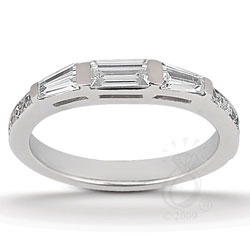Moissanite? What the heck is that? Does a baguette setting go with butter and jelly? Do I really want fire in my diamond? Won’t that hurt?
Jewelry terminology is a language in and of itself. Here at Joseph Schubach Jewelers, we’re happy to provide you with needed information so you can make a smart and educated jewelry purchase.
So sit down, boys and girls…and take that gum out of your mouth.
Here’s a quick lesson to get you started:
Baguette setting — A rectangular-shaped stone with rows of step-like facets. If the baguette’s two long sides taper inward, it is called a Tapered baguette. Baguettes in long, thin cut rectangles are often used as enhancements to a lager center stone, or on a watch bezel.
Bar setting — Similar to the channel setting, it is a circular band of diamonds or gemstones that holds each stone in by a long thin bar, shared between two stones.
Barion cut — This has a traditional step-cut crown and a modified brilliant-cut pavilion. A square barion cut diamond has 61 facets, excluding the culet.
Bearding or girdle fringes — The outermost portion of the stone, called the girdle, can develop small cracks that resemble whiskers during the polishing process. The bearding can sometimes be removed, if not too dramatic, with slight re-polishing, and if the weight allows.
Bezel — With a bezel setting, a rim holds the stone and completely surrounds the gem. It is the upper portion above the girdle of a cut stone. Bezels can have straight edges, scalloped edges, or can be molded into any shape to accommodate the stone. A watch bezel is the upper part of the case surrounding the dial. They can be set with diamonds or other gemstones.
Blemishes — The term blemish is used when the diamond has scratches or marks on the external area of the stone.
Brilliance — Liveliness, or sparkle in a stone when light is reflected from the surface and from the total internal reflection of light.
Brilliant-cut — Brilliant cuts are scientifically found to reflect the most light from within the stone, and often are considered to have the most brilliance of all cuts. A round brilliant-cut diamond has 58 facets. Other brilliant cuts include the heart, oval, marquise and pear shaped.
Cabochon — A facet-less style of cutting that produces a smooth surface. They can be in many shapes, including round with high domes to squares.
Carat — Unit of measure of weight of diamonds and gemstones. One carat is equivalent to 200 milligrams. One carat can also be divided into 100 “points.” A .75-carat stone is the same as a 75-point or 3/4-carat stone.
Certification (or Diamond Grading Reports) — There are many recognized gemological laboratories that can grade your stones for a fee. The most well known is the GIA, Gemological Institute of America.
Channel setting — Used most frequently for wedding and anniversary bands, a channel setting will set the stones right next to each other with no metal separating them.
Clarity — A diamond often has natural imperfections, commonly referred to as inclusions, which contribute to its identifying characteristics. Inclusions are found within the diamond, and can be white, black, colorless, or even red or green. Most are undetectable by the human eye, and can only be seen with 10X magnification. Inclusions are ranked on a scale of perfection called clarity.
Cleavage — A natural area of the diamond where a weak bond holds the atoms together. The gem will be split along these planes by the cutter.
Cluster setting — This setting surrounds a larger center stone with several smaller stones. It is designed to create a beautiful larger ring from many smaller stones.
Color — Diamonds are graded on a color scale established by the Gemological Institute of America (GIA). Fancy colors refer to diamonds with hues like pink, blue, green, yellow, and very rarely red. Fancy colors are not included in this color scale and are considered extremely rare.
Crown — This is the upper portion or the top of a diamond.
Culet — The bottom point of the diamond. It may be polished in some stones. Sometimes, a cutter may choose to make the culet a surface instead of a point.
Cushion cut — A mixed-cut diamond shaped like a square pillow.
Cut — Cut refers to the angles and proportions a skilled craftsman creates in transforming a rough diamond into a polished diamond. Based on scientific formulas, a well-cut diamond will internally reflect light from one mirror-like facet to another and, disperse and reflect it through the top of the stone. This results in a display of brilliance and fire. Diamonds that are cut too deep or too shallow lose or leak light through the side or bottom, resulting in less brilliance, and ultimately value.
Cutting style — Cutting styles are different than diamond shapes. The simplest and most common way to explain cutting style is to categorize it into the following three basic types: Step-cut, Brilliant-cut and Mixed-cut.
Deep cut — When a diamond is cut too deep, it will lose or leak light through the side or bottom. This results in less brilliance and value.
Diamond — A diamond is the hardest known natural substance. It is crystallized carbon. Diamonds are mined in their rough form and then, cut and polished to reveal their brilliance.
Diamond Grading Reports — There are many recognized gemological laboratories that can grade your diamond for a fee. The most well known is the GIA, Gemological Institute of America.
Dispersion — When light enters a diamond it reflects off the facets and the angles cut into the stone. This distribution of light is known as dispersion, or the display of the spectral colors.
Source: Jewelry.com
A baguette:
Wedding band with baguette stones (do not eat!)
Style 10151WB
Wedding Band With Round And Baguette Stones
Matching wedding band with approximately 2/3ct t.w. round brilliant and baguette stones.


